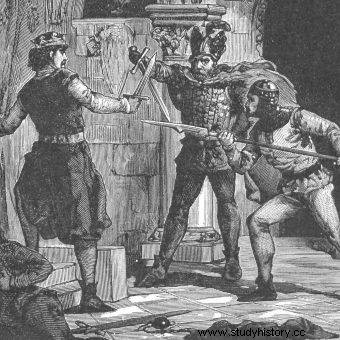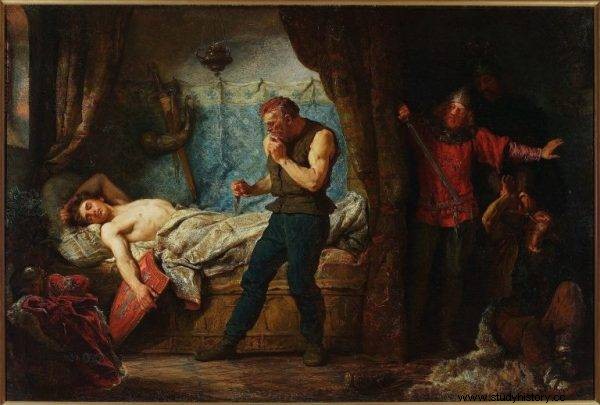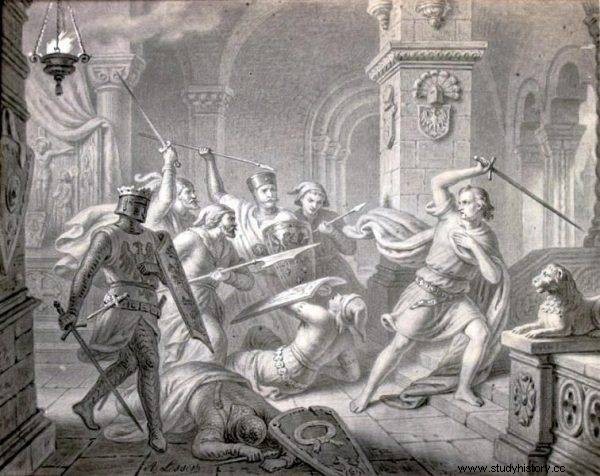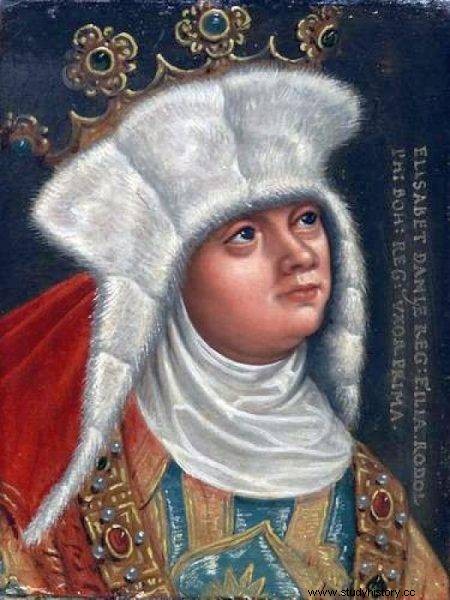When in December 1283 the news of Ludgarda's sudden death spread, the people of Greater Poland immediately indicated the culprit. Also Jan Długosz believed that the duchess had died on the orders of her husband. To this day, historians have argued whether Przemysł II really had a hand in it. What was it really like?
At the beginning of 1257, Duchess Elisabeth became pregnant, but Przemysł I did not live to see the birth of this descendant. The tombstone son was born on October 14 of the same year, four months after the death of the prince. Bishop Boguchwał baptized him in the Poznań cathedral, giving him the Slavic name Przemysł after his father, meaning "clever", "wise", "clever". The full power over Wielkopolska, which was then a completely independent state, was taken over by Przemysł's uncle - Bolesław. Little Przemko grew up under his care, educated by learned monks and trained in knightly craft (...).
And they lived happily ever after?
When the boy reached the age of 16, his uncle decided to marry him. The young prince went to Szczecin to meet the candidate, granddaughter of the prince of Szczecin - Ludgarda. He was two years younger than him, the girl he liked . After a brief introduction to each other, a wedding was organized on the spot.
At that time, 14-year-olds were considered mature for sexual life, so it was also possible to arrange decks. Industry immediately returned to Wielkopolska, while Ludgarda stayed for some time in Szczecin, preparing to move. She was later solemnly welcomed in the border town of Drezdenko, where she arrived with her court.

Did Industry II have anything to do with Ludgarda's mysterious death?
The spouses together with Bolesław, his wife Jolenta and a group of dignitaries set off in one retinue to Poznań. It seemed that the couple would have a harmonious and happy relationship, especially since Industry showed no penitential tendencies in the style of his godly parent.
Having reached an adult age, the prince demanded that his uncle assign him a separate rulership - the Poznań district - and after a short conflict he achieved his goal. Bolesław did not have a son and it was known that the entire province would be taken over by his nephew in the future . (…) He did not wait long for the rest of Wielkopolska to be taken over. In April 1279, Bolesław suffered a fever attack and fainted. Feeling death imminent, he called his nephew to his bedside and entrusted him with the care of his wife and daughters. Shortly thereafter, he closed his eyes forever.
Industry (...) probably already started thinking about the royal crown on its head. All the more, however, he was tormented by a serious problem related to it:in his marriage to Ludgarda, he still couldn't wait for a son.
Remedy for no child
It can be assumed that he created a well-defined vision of the future in his mind. He wanted to consistently follow the road that culminated in royal power, while at the same time preparing his male heir to replace him on the throne in the future. This need could have been all the stronger as he grew up alone without a father. Not surprisingly, his nervous impatience as he awaits the desired heir.
Ludgarda and her courtiers were undoubtedly trying to somehow remedy the problem by looking for different specifics against infertility . There was no shortage of ideas then. Educated at the French university in Montpellier, Nicholas - a Dominican, court medic of the Duke of Sieradz - proclaimed, for example, that eating lizards and frogs helps in any trouble. We do not know whether the desperate Duchess of Greater Poland tried his recommendations. In any case, the years passed and Ludgarda did not get pregnant.
As time passed and hope faded, the relationship between the princely couple deteriorated more and more. In the early 1980s, there was not even a trace of a former teenage infatuation. Industry, as it used to be, blamed his wife for infertility, making her feel impatient, then resentment, and finally - even hate.

It is possible that the people who murdered Przemysł II wanted to take revenge on him for the murder of Ludgardy.
The life of the duchess turned into a streak of torment. Lonely, rejected by her husband, treated coolly by the court surroundings, she withered like an autumn leaf. She stayed mostly in her chambers, not taking part in public events and celebrations.
The industry seemed to be ashamed of its wife, the mere sight of her made him feel bad, irritated and even angry. Divorce was obviously not an option , was forbidden by the Church. However, the prince had another way of getting rid of his wife at his disposal.
The mysterious death of Ludgarda
Ludgarda died between 11 and 15 December 1283 in the castle in Gniezno. At that time, industry was located in the duke's estate near Pyzdry. " Because of his wife's infertility and the desire of a male heir, he has sent some people to kill her "- wrote the 15th-century chronicler Jan Długosz. According to his account, the Duchess sensed beforehand what might await her and even begged her husband, crying, to send her home, to Pomerania.

Fate made fun of Przemysł II. He himself also died at the hands of the assassins.
But it didn't do anything. The monarch ordered the servants to kill his wife while he was away. After he left, the woman was strangled with pillows by servants. "Industry assumed," the historian continued, "that his crime, about which few people knew, would drown in eternal silence." However, it happened otherwise. The news of the death of the 23-year-old duchess spread across Greater Poland like wildfire, causing great commotion.
The common people had no doubt that the ruler was behind the murder. The tragedy was quickly reflected in the folk songs and tales of the unhappy duchess and her cruel spouse, multiplying like mushrooms after the rain .
The Greater Poland Piast was prudently not mourning too much. He knew very well that hardly anyone would be fooled to show hypocrisy, and that mock regret would only increase suspicion. Meanwhile, he was intensively looking for another candidate for the mother of his successor. A suitable girl was found quite far away, as far as Sweden.
Ryksa was the niece of the Swedish king Magnus, brought up at his court. The industry sent their notary, Tylon, north to marry on his behalf. This happened on October 11 in Nyköping. Then the emissary brought the bride to Wielkopolska, where the wedding ceremonies took place.

Przemysł II dreamed of a son, but Ludgarda did not give him any heir. Is that why she died? In the end, the ruler had only Ryksa's daughter Elżbieta (with his second wife).
The Swedish ruler liked the Poznań ruler. Perhaps she was prettier than he had expected, and he was pleasantly surprised. It can also be assumed that in terms of temperament they were a more matched pair than Przemysł and Ludgard . In official documents, the monarch later spoke warmly about his Scandinavian half, calling her "beloved wife".
The uplifted prince set about with renewed enthusiasm the realization of his great plans. By night he worked vigorously to beget a heir, by day he assembled political alliances, made plans, plotted intrigues.
Source:
The above text is an excerpt from Marcin Szymaniak's book, Polish bombings , published by the Znak Horyzont publishing house.
The title, lead, illustrations with captions, bolds and subtitles come from the editorial office. The text has undergone some basic editing to introduce more frequent paragraph breaks.
